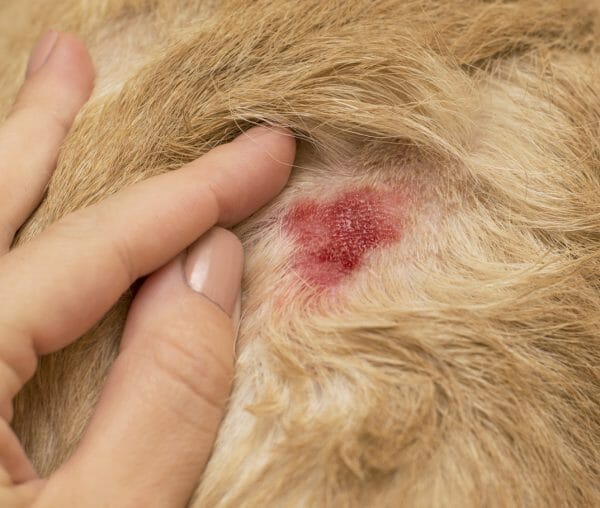Skin Infection in Dogs
In debating what may be one of the most frequent issues that come into a vet’s office, pyoderma (skin infections) takes the cake. Because of the fact a simple cut or scrape in a canine’s skin can trigger infection, one can imagine how common pyoderma is in the canine world.
Skin infections in dogs can range from minor to severe. The key is to get the root cause of the pyoderma evaluated and treated as soon as it arises. In most cases, consistent use of antibiotics is all that is needed. If the vet’s instructions are closely followed, the prognosis for pyoderma is very good.
What is Pyoderma?
Pyoderma in dogs is an infection occurring within the dog’s skin that may be parasitic, fungal, or bacterial in nature. As mentioned previously, pyoderma can arise when a lesion in the skin allows for an infection to enter, grow, and fester within the wound. (A surface pyoderma is also known as hot spots on dogs.)
These skin conditions usually manifest themselves in an instantly recognizable manner. Not only is pyoderma extremely irritating to the dog, but the skin can become red, and painful pustules can form. After looking at a few pictures of pyoderma infections, one can only imagine how excruciating this condition must be for the canine.
This is why it is critical for canines to see a vet and receive treatment for pyoderma immediately. If treatment is sought early on, the pyoderma should go away quickly with no issues. However, if pyoderma is ignored, it could possibly spread to other areas of the body, which will substantially worsen the situation and endanger the dog’s health.

How Do Dogs Get Pyoderma?
Any opening within the skin can be a breeding ground for infection. When the skin is broken, the dog will usually paw or bite at it, which makes the situation worse. This can prevent the skin from being allowed to heal properly, which can result in pyoderma.
There are a multitude of reasons why the skin’s normal bacteria may be prevented from facilitating healing. For example, the canine’s immune system may also be weakened by a preexisting condition, which makes healing slow and inefficient. Although fungal or parasitic infections do occur, bacterial infections brought about by Staphylococcus are the most common causes of pyoderma.
Root Causes of Pyoderma
Below are the most common issues that can leave a dog vulnerable to pyoderma:
- Autoimmune disorders (such as hypothyroidism)
- Unhealthy diet
- Skin allergies or hypersensitivities
- Medications that can inhibit normal functioning of the immune system
- Insect bites, ear mites infestation, or worms
- Tumors
- Cancer
- Skin burns
Each of these issues can cause the dog to claw at or lick the affected area. One of these root causes combined with constant irritation to the skin can bring about acute infections.

Puppy Pyoderma
Dogs of all ages can develop pyoderma, even puppies. Often referred to as impetigo in puppies, these infections take place in areas of the body that have the thinnest hair, such as underneath the limbs or in the groin area.
Signs of Skin Infection in Dogs

Bacterial skin infections may be localized in one area of the body or could be spread all over. Because these infections occur more often in the folds of the skin, dog breeds with multiple skin folds (such as Bulldogs, Pugs, and Basset Hounds) tend to get pyoderma more than other dog breeds.
Listed below are the symptoms seen in dogs suffering from infections within the skin:
- Raised, inflamed bumps (often resemble pimples)
- Loss of hair around the infection
- Crusty, flaking skin
- Pus-filled bumps
- Splotchy, discolored skin coloring
- Dried blood or discharge around the lesion
- Scratching, licking, or biting of the skin by the dog
Due to the unsightly appearance of pyoderma, these infections are very noticeable to the naked eye. It is important for the dog to be seen quickly by a vet. This will not only benefit the dog’s health but alleviate the discomfort and annoying itchiness it may be experiencing.
Diagnosing Skin Infections
Once raw, pustule-filled skin is noticed and the dog begins to exhibit agitated behavior, the dog should be taken to the vet for diagnosis. Although most cases of pyoderma can be easily diagnosed after a physical examination is conducted, the vet will most likely want to establish the source of what is causing the infection.
Although microscopic analysis of discharge from the infection is the most used diagnostic method, the vet may also use one or more of the following diagnostic tests to determine what is causing the pyoderma:
- Biopsy (a small part of the skin is taken and analyzed)
- Testing for allergies
- Scraping of the skin (non-invasive skin scrape is analyzed)
- Blood tests (used to determine if endocrine diseases or hypersensitivities are present)
- Bacterial and fungal cultures (small samples of hair or the skin itself is taken)
Each of these tests is utilized to accurately establish the cause of the pyoderma, as well as determining which antibiotics will be most effective in treatment.
Pyoderma Treatment
Whether it be severe or mild pyoderma, antibiotics prescribed by the vet are the usual go-to treatment. Treatment usually begins with a thorough cleaning of the affected area. Following this, the vet will prescribe an oral or topical antibiotic. For cases of canine fungal infection, antifungal medications will be prescribed.
Medications for Treating Pyoderma
Because bacteria are most common causes of pyoderma, one of the following antibiotic medications are normally prescribed:
- Amoxicillin
- Enrofloxacin
- Cephalexin
- Clindamycin

It is important to adhere to the vet’s instructions exactly in terms of medicine type, dosage, and frequency of administration. For antibiotics, in particular, treatment should be seen through in its entirety.
Most of these prescribed medications will need to be taken for 3 to 4 weeks without stopping. If treatment is stopped prematurely, the pyoderma could be exacerbated.
Medicated topical shampoos, conditioners, gels, and sprays may also be prescribed to reinforce the efficacy of the pyoderma treatment regimen.
As always, follow up with the dog’s doctor for any questions or concerns regarding skin infections. If the pyoderma worsens significantly, even during treatment, notify the vet immediately.



